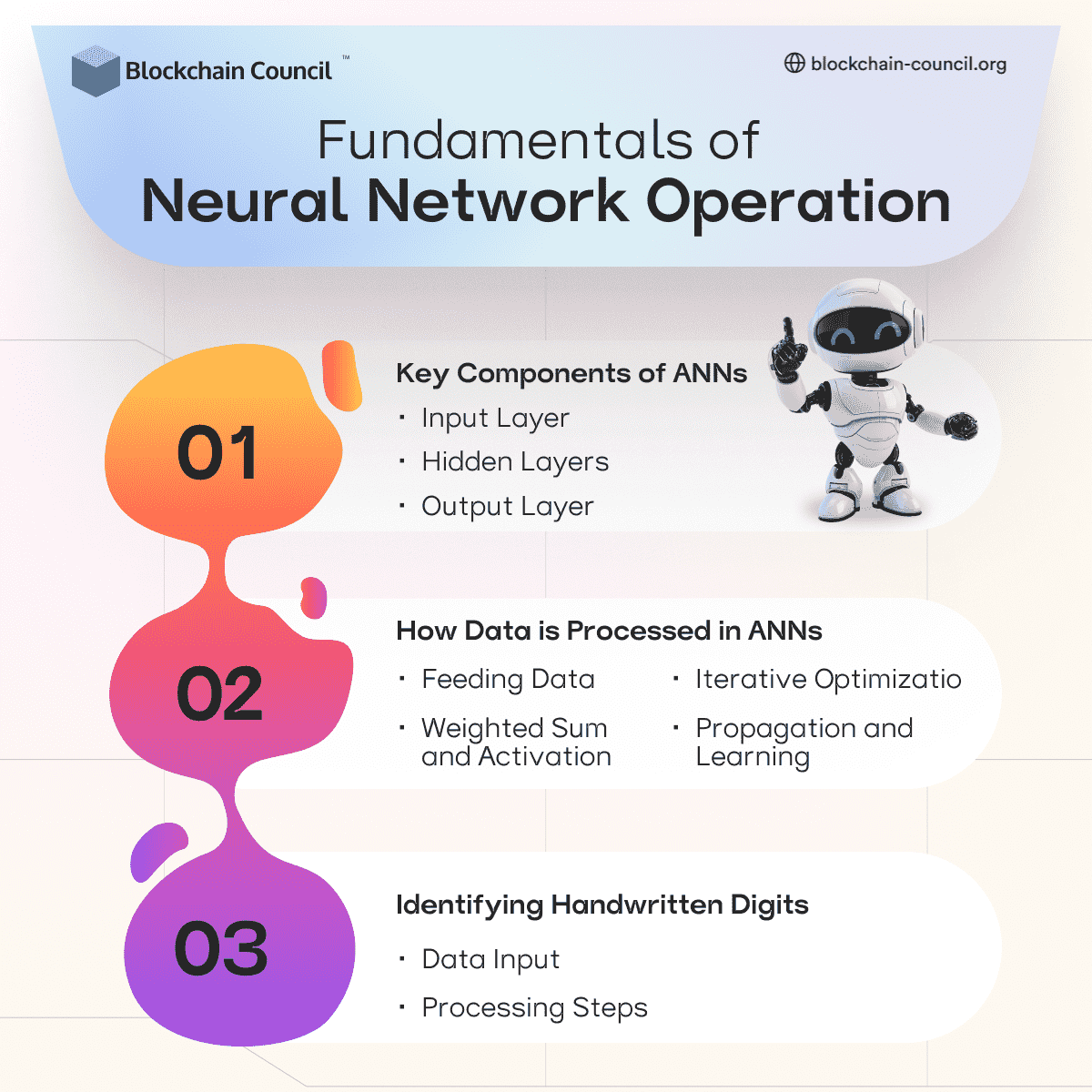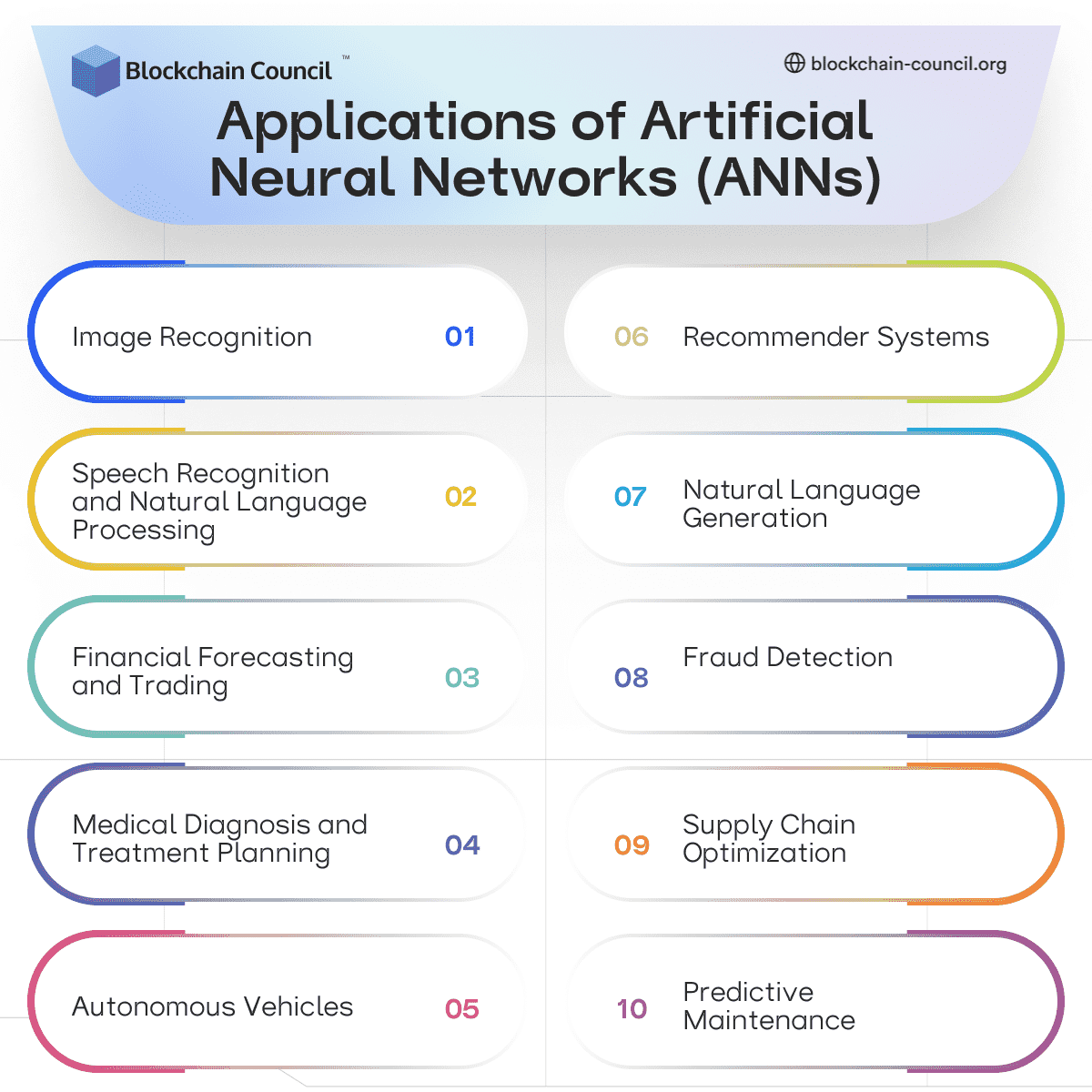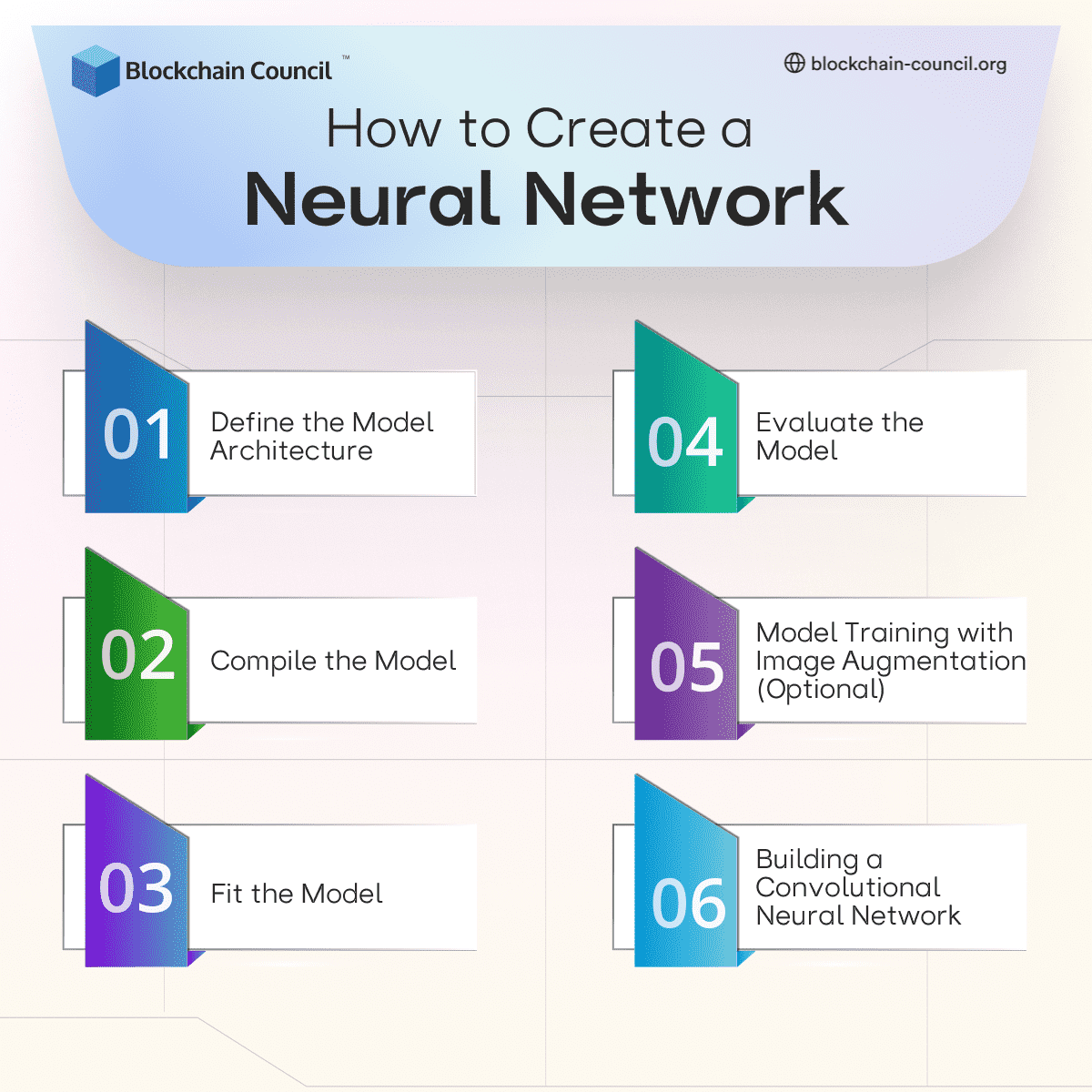
- Blockchain Council
- September 02, 2024
Introduction
Artificial Neural Networks, often abbreviated as ANNs, are a crucial component of modern technology, playing a pivotal role in various applications like image recognition, natural language processing, and more. If you’ve ever wondered how these systems work and what makes them so powerful, you’re in the right place.
In this beginner’s guide to Artificial Neural Networks (ANNs), we embark on an exploration of one of the most fascinating and transformative areas of modern artificial intelligence. ANNs draw their inspiration from the intricate workings of the human brain, specifically its neural networks. These networks, composed of interconnected neurons and synapses, form the foundational structure of ANNs.
By imitating this biological blueprint, ANNs are capable of learning, adapting, and making decisions, thereby playing a pivotal role in various AI applications. Let’s begin by delving into the core concepts behind ANNs, elucidating their definition, structure, and the remarkable way they mimic our own neural architecture to process information and solve complex problems.
The Basic Structure of ANNs
Definition of ANNs
Artificial Neural Networks (ANNs) are a fundamental concept in the field of artificial intelligence, mimicking the structure and function of biological neural networks found in the human brain. ANNs are composed of interconnected units or nodes, often referred to as artificial neurons, which closely resemble the neurons in a biological brain. These artificial neurons are linked together through structures analogous to synapses, which facilitate the transmission of signals between neurons.
In an ANN, each neuron processes incoming data and passes on its output to subsequent neurons. The connections between these neurons, known as weights, are adjusted through a learning process, enabling the network to learn from and adapt to presented data. This structure of interconnected neurons and synapses forms the basic architecture of ANNs, allowing them to perform complex tasks like pattern recognition, decision making, and predictive modeling.
The strength of ANNs lies in their ability to learn and make intelligent decisions based on the data they receive, making them a powerful tool in various applications, from image and speech recognition to predictive analytics.
Fundamentals of Neural Network Operation
Understanding the Architecture of Artificial Neural Networks (ANNs)
Artificial Neural Networks (ANNs) are the cornerstone of modern machine learning and artificial intelligence. These networks, inspired by the biological neural networks of the human brain, excel in tasks like pattern recognition, data classification, and even complex problem-solving.
Key Components of ANNs:
- Input Layer: The gateway through which data enters the ANN. For example, when identifying handwritten digits, the input layer receives the pixel values of the image.
- Hidden Layers: These layers, positioned between the input and output layers, are where the complex computations occur. They consist of ‘neurons’ that apply weights and biases to the inputs and pass them through activation functions to derive meaningful patterns or features.
- Output Layer: This layer presents the final output. In our example of digit recognition, the output layer would indicate which digit (0-9) the network believes the input image represents.
How Data is Processed in ANNs:
- Feeding Data: Initially, the network receives the input data (e.g., an array of pixel values for handwritten digit images).
- Weighted Sum and Activation: Each neuron in the hidden layers computes a weighted sum of its inputs and then applies an activation function (like ReLU or Sigmoid). This process transforms the input data into a format that the network can use to learn patterns.
- Propagation and Learning: The transformed data is propagated through the network, reaching the output layer. The network then compares its output with the actual label (correct digit) using a loss function, adjusting its weights through backpropagation—a fundamental process where the ANN learns from its errors.
- Iterative Optimization: Through numerous iterations and exposure to various data examples, the ANN refines its weights and biases, enhancing its ability to identify and categorize data accurately.
Identifying Handwritten Digits:
- Data Input: For digit recognition, typically, the MNIST dataset is used, consisting of thousands of handwritten digit images.
- Processing Steps: Each image, represented as a matrix of pixel values, is fed into the input layer. The hidden layers then extract features like edges, curves, and angles, crucial for distinguishing between different digits.
- Final Prediction: The output layer, often employing a softmax activation function for classification tasks, provides a probability distribution over the 10 digit classes (0-9), indicating the network’s prediction.
Key Concepts in Neural Networks
Understanding Forward Propagation: How Data Flows from Input to Output
Forward propagation in neural networks refers to the process where input data is fed forward through the network to generate an output. In a typical neural network architecture, which includes input, hidden, and output layers, forward propagation starts at the input layer. Each neuron in the hidden layers processes the data based on an activation function and passes it successively forward until it reaches the output layer. This process is crucial for avoiding a circular flow of data, which would impede the generation of an output.
During forward propagation, each neuron in the hidden and output layers undergoes two main processes: preactivation and activation. Preactivation is essentially the weighted sum of the inputs, a linear transformation based on the weights assigned to these inputs. The activation phase involves passing this weighted sum through an activation function, introducing non-linearity to the network and determining whether to pass the information further.
Backpropagation and Gradient Descent: Mechanisms for Learning and Adjusting Weights
Backpropagation: This is a training algorithm vital for improving neural network predictions. It functions by iteratively improving the network’s output. In a feedforward neural network, backpropagation propagates the error, which is the difference between the actual and predicted outputs, backward from the output layer to the input layer. This error is then used to calculate the gradient of the cost function with respect to each weight, effectively allowing the adjustment of weights to reduce output error. Backpropagation employs the chain rule for calculating these gradients, a critical step in adjusting the weights for error minimization.
Gradient Descent: This optimization algorithm is used alongside backpropagation to find the weights that minimize the cost function of the neural network. The process involves navigating down the cost function to find its minimum point, which corresponds to the optimal weights. To do this effectively, gradient descent requires knowledge of the direction to navigate (determined by the gradient calculated through backpropagation) and the size of the steps for navigation (determined by the learning rate). The learning rate is a tuning parameter that significantly influences the balance between optimization time and accuracy. A high learning rate can lead to faster learning but risks overshooting the minimum point, while a low learning rate ensures precision but may be time-consuming.
Activation Functions in Neural Networks
Activation functions are pivotal in neural network operations, serving as the decision-makers that determine whether a neuron should activate or remain inactive based on the received inputs. They are crucial for introducing non-linearity into the network, enabling it to learn and represent complex patterns within data.
Commonly Used Activation Functions
Several activation functions are commonly used in neural networks, each with unique characteristics and applications:
Sigmoid Function:
- Description: The Sigmoid function outputs values in the range (0,1). It’s like a neuron’s firing rate, highly sensitive in the middle range and less responsive at the extremes.
- Advantages and Disadvantages: It’s easy to derive and has been widely used in early deep learning developments. However, it’s not zero-centered, can be computationally intensive due to exponential operations, and may suffer from gradient vanishing problems during backpropagation.
Tanh Function:
- Description: Tanh, or hyperbolic tangent, is similar to the Sigmoid function but outputs values in the range (-1,1), making it zero-centered.
- Advantages and Disadvantages: Tanh offers a smoother gradient and a broader output range than Sigmoid, aiding in stable optimization. However, it can also suffer from gradient vanishing in deep networks and is computationally intensive.
ReLU Function:
- Description: Rectified Linear Unit (ReLU) is straightforward, outputting the maximum value between zero and its input.
- Advantages and Disadvantages: ReLU is efficient and addresses the vanishing gradient issue. It induces sparsity in activations and is computationally faster than Sigmoid and Tanh. A disadvantage is the ‘dying ReLU’ problem, where negative inputs can lead to inactive neurons.
Leaky ReLU Function:
- Description: To mitigate the ‘Dead ReLU’ issue, Leaky ReLU allows a small, non-zero gradient for negative inputs.
- Advantages and Disadvantages: Leaky ReLU prevents inactive neurons and avoids gradient saturation, but it requires tuning of the ‘leakiness’ parameter and is not universally superior in all cases.
ELU (Exponential Linear Units) Function:
- Description: ELU aims to address challenges posed by ReLU, allowing a small gradient for negative inputs.
- Advantages and Disadvantages: It eliminates the ‘Dead ReLU’ problem and offers a zero-centered output, which aids specific optimization algorithms. However, it can be more computationally intensive due to its exponential nature.
Training Neural Networks
Supervised, Unsupervised, and Reinforcement Learning: Different Training Methodologies
- Supervised Learning: In supervised learning, the algorithm is trained on a fully labeled dataset, where each example is tagged with the correct answer. This method is akin to learning under supervision, where the algorithm’s accuracy is continually assessed against the provided labels. For instance, a labeled dataset of flower images would specify which photos are of roses, daisies, and daffodils. The model learns to predict labels based on these examples.
- Unsupervised Learning: Unsupervised learning involves training a model on a dataset without predefined labels. The algorithm must discern structures and patterns in the data autonomously. This method is essential when clean, labeled datasets are unavailable or when the questions posed to the algorithm do not have predetermined answers. Common applications include clustering, where data are grouped based on similarities, and anomaly detection, where outliers in data are identified.
- Reinforcement Learning: This methodology is about training an algorithm through a system of rewards and penalties. It mimics the way players receive cues in video games, where certain actions lead to rewards or penalties. The AI agent learns to perform tasks or achieve goals by maximizing cumulative rewards over time. This approach is effective in scenarios like training robots for autonomous navigation or inventory management.
The Concept of Epochs in Training and Challenges like Overfitting and Underfitting
Epochs in Training
An epoch in neural network training represents one complete cycle through the entire training dataset. Multiple epochs are often required for the model to learn effectively. Each pass through the dataset allows the algorithm to adjust its weights and improve its accuracy in prediction.
Challenges of Overfitting and Underfitting
- Overfitting: This occurs when a model learns the training data too well, including its noise and outliers, leading to poor performance on new, unseen data. Overfitting is akin to memorizing answers without understanding underlying concepts, limiting the model’s ability to generalize.
- Underfitting: Conversely, underfitting happens when a model fails to capture the underlying trend in the data. It can occur if the model is too simple or if the training cycles (epochs) are insufficient.
Applications of Artificial Neural Networks (ANNs)
Artificial Neural Networks (ANNs) have seen remarkable advancements and are being applied across a diverse range of fields, significantly impacting the way we interact with technology and approach problem-solving. Here’s an in-depth look at some of the key applications of ANNs as of 2023:
Image Recognition
ANNs play a crucial role in computer vision, helping in object, people, and scene identification in images and videos. This technology is integral in areas like surveillance, autonomous vehicles, and medical imaging, where pattern recognition and predictive capabilities are essential.
Speech Recognition and Natural Language Processing (NLP)
ANNs are pivotal in transcribing spoken words into text and analyzing the meaning of text. These technologies are fundamental in virtual assistants, customer service chatbots, and applications requiring understanding and responding to human speech.
Financial Forecasting and Trading
In the financial sector, ANNs are utilized for market trend analysis and stock price predictions, aiding in investment strategies and risk minimization for hedge funds, banks, and other financial institutions.
Medical Diagnosis and Treatment Planning
ANNs enhance medical diagnosis by analyzing images and patient data to identify diseases. They also assist in developing personalized treatment plans, thereby improving the accuracy and effectiveness of medical treatments.
Autonomous Vehicles
In the realm of self-driving cars, drones, and other autonomous vehicles, ANNs analyze sensor data to make navigational decisions, pushing the boundaries of technology in transportation.
Recommender Systems
These systems use ANNs to analyze user behavior and suggest products, services, and content, enhancing user experience on e-commerce sites and streaming services.
Natural Language Generation
ANNs are now being used to generate human-like text in news articles, reports, and other content forms, showcasing their ability to mimic human writing styles.
Fraud Detection
Financial institutions employ ANNs to analyze transactions and detect patterns indicative of fraud, improving security measures and reducing fraud risks.
Supply Chain Optimization
ANNs help in analyzing data across the supply chain to identify inefficiencies, aiding companies in streamlining processes, reducing waste, and enhancing overall performance.
Predictive Maintenance
In the field of equipment maintenance, ANNs are used to predict equipment failures, reducing maintenance costs and downtime.
These applications demonstrate the versatility and transformative potential of ANNs across various industries. From healthcare to finance, transportation to customer service, ANNs are revolutionizing the way we approach complex problems and data-driven decision-making.
How to Create a Neural Network
Creating a neural network using Keras involves several steps, from defining the model architecture to compiling, training, and evaluating the model. Here’s a detailed guide to building a basic neural network using Keras:
1. Define the Model Architecture:
- Start by importing Keras and its Sequential model, as it allows you to create models layer-by-layer linearly.
- Define the layers of your neural network. For instance, a simple network might include an input layer, multiple hidden layers, and an output layer. Each layer is defined using the Dense class in Keras, where you specify the number of neurons and the activation function. Commonly used activation functions are ReLU for hidden layers and Sigmoid or Softmax for the output layer, depending on your problem type.
2. Compile the Model:
- After defining the model, you need to compile it, which involves specifying a loss function and an optimizer.
- Loss functions such as Mean Squared Error (MSE) for regression problems, or Binary Crossentropy for binary classification, are selected based on the problem type.
- Choose an optimizer like Stochastic Gradient Descent (SGD) or Adam, which helps in minimizing the loss function during training. The Adam optimizer is a popular choice for its efficiency in a wide range of problems.
3. Fit the Model:
- Fitting the model is the training phase where you expose your model to the data. This involves defining epochs and batch sizes. An epoch is one complete pass through the entire training dataset, while a batch size is the number of samples processed before the model is updated.
- Use the fit() method to train the model on your data. This method requires your training data and corresponding labels, along with the number of epochs and batch size.
4. Evaluate the Model:
- Once the model is trained, evaluate its performance on a test set or validation set using the evaluate() method. This gives you the loss value and other metrics like accuracy for your model.
- It’s important to note that the performance on the training set might not always reflect the true predictive power of the model on unseen data.
5. Model Training with Image Augmentation (Optional):
- In cases like image processing, you can use techniques like Image Augmentation to increase your dataset size and variety, which helps in improving the model’s generalization.
- Image Augmentation involves modifying your training images slightly (e.g., rotating, flipping, adding noise) to generate new training samples.
6. Building a Convolutional Neural Network (CNN) (For Image Processing Tasks):
- CNNs are particularly effective for image processing tasks. A typical CNN architecture includes convolutional layers for feature extraction, pooling layers for reducing dimensionality, and dense layers for classification.
- In a CNN, you will use layers like Conv2D for convolutional operations, MaxPooling2D for pooling operations, and Flatten to convert the two-dimensional image data into a one-dimensional array for the fully connected layers.
The specific architecture, loss function, optimizer, and other parameters can be adjusted based on the problem at hand and the nature of the data.
Challenges of Artificial Neural Networks
Creating a comprehensive understanding of Artificial Neural Networks (ANNs) involves not only grasping their current capabilities but also acknowledging the challenges they face and the future direction of their development.
Challenges in Training ANNs
- Data Dependency: ANNs require large datasets for training, making them data-intensive. Acquiring sufficient, high-quality data can be a significant challenge.
- Computational Resources: Training complex neural networks demands substantial computational power, often necessitating advanced hardware like GPUs.
- Overfitting: A common challenge is overfitting, where the model performs well on training data but fails to generalize to new data.
- Hyperparameter Tuning: Selecting the optimal set of hyperparameters for a model can be a tedious and time-consuming process.
- Explainability: ANNs, especially deep learning models, are often seen as black boxes, with limited understanding of how they make decisions.
Future Directions of Neural Network Research and Applications
- Improved Efficiency: Research is focusing on developing more efficient models that require less computational power and data.
- Enhanced Explainability: Efforts are being made to make ANNs more transparent and understandable, improving their usability in critical applications.
- Integration with Other AI Technologies: Combining ANNs with other AI and machine learning techniques for more robust and versatile applications.
- Expansion into New Fields: ANNs are expected to expand into new domains, solving more complex and diverse problems.
- Advancements in Hardware: Development of specialized hardware to better support the unique requirements of neural network processing.
Conclusion
Artificial Neural Networks represent a cornerstone of modern AI and machine learning, offering unparalleled capabilities in pattern recognition, data analysis, and predictive modeling. While they come with challenges like data intensity, computational demands, and a lack of explainability, ongoing research and technological advancements continue to enhance their efficiency, transparency, and applicability across various domains. The future of ANNs is poised for growth, with potential breakthroughs in efficiency and new applications that could reshape numerous industries.
Frequently Asked Questions
What do you mean by artificial neural network?
- Artificial Neural Network (ANN) mimics the structure and function of biological neural networks in the human brain.
- It consists of interconnected artificial neurons that process information and adapt through a learning process.
- ANNs are used for tasks like pattern recognition, decision making, and predictive modeling.
- They can learn from data, make intelligent decisions, and excel in various applications such as image recognition and natural language processing.
What is an example of a neural network?
- An example of a neural network is used in digit recognition, where the network processes pixel values of handwritten digits.
- Another example is in image recognition, identifying objects, people, or scenes in images and videos.
- Basics include layers like the input layer, hidden layers, and output layer.
- Neurons in the network process data, apply weights, and adapt through learning.
- Forward propagation moves data through the network, and backpropagation adjusts weights for error minimization.
- Activation functions, like ReLU or Sigmoid, introduce non-linearity, influencing learning capabilities.








































































 Guides
Guides News
News Blockchain
Blockchain Cryptocurrency
& Digital Assets
Cryptocurrency
& Digital Assets Web3
Web3 Metaverse & NFTs
Metaverse & NFTs
